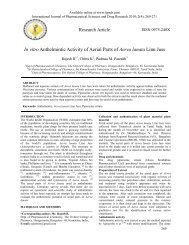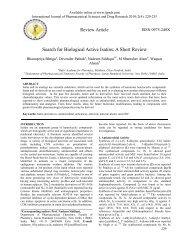Lawsonia inermis Linnaeus - International Journal of ...
Lawsonia inermis Linnaeus - International Journal of ...
Lawsonia inermis Linnaeus - International Journal of ...
Create successful ePaper yourself
Turn your PDF publications into a flip-book with our unique Google optimized e-Paper software.
Chaudhary et al. / <strong>Lawsonia</strong> <strong>inermis</strong> <strong>Linnaeus</strong>: A Phytopharmacological ……………….<br />
Antisickling activity<br />
Aqueous extract <strong>of</strong> leaves <strong>of</strong> L. <strong>inermis</strong> was found to inhibit<br />
sickling and to increase the oxygen affinity <strong>of</strong> HbSS blood.<br />
[74]<br />
Abortifacient activity<br />
Methanol extract <strong>of</strong> roots <strong>of</strong> L. <strong>inermis</strong> was most effective in<br />
inducing abortion in mice, rats and guinea pig. The effect<br />
apparently was dosage dependent. The results <strong>of</strong> the whole<br />
animal experiments support the methanol extract<br />
effectiveness as an abortant due to its maternal and foetal<br />
toxic effects. [75]<br />
Enzymes inhibitory activity<br />
The ethanol extract <strong>of</strong> L. <strong>inermis</strong> L. leaves and lawsone<br />
tested for trypsin inhibitory activity showed an IC50 value <strong>of</strong><br />
64.87 and 48.6µg/ml, respectively. [76]<br />
Memory and behaviour effectiveness<br />
L. <strong>inermis</strong> showed significant effect on memory and<br />
behaviour mediated via monoamine neurotransmitters. [77]<br />
Nematicidal effect<br />
A suppressive effect was obtained by L. <strong>inermis</strong> against<br />
Meloidogyne incognita development. Henna reduced tomato<br />
root gall numbers, number <strong>of</strong> the egg-laying females and rate<br />
<strong>of</strong> the nematode reproduction, when tomato and henna were<br />
grown together. Also, same reduction in the nematode<br />
biological processes was found, when tomato plants were<br />
grown in soil containing root exudates <strong>of</strong> henna, but with less<br />
amount. When henna was grown alone, root gall index and<br />
the rate <strong>of</strong> nematode production reduced to 75% and 99%,<br />
respectively, compared with those <strong>of</strong> tomato grown alone. [78]<br />
Anticoagulant effect<br />
Lawsone and its oxazine derivatives isolated from leaves <strong>of</strong><br />
L. <strong>inermis</strong> had proven to be potential anticoagulant agent. [79]<br />
Wound healing effects<br />
Chlor<strong>of</strong>orm and aqueous extracts <strong>of</strong> leaves <strong>of</strong> the plant were<br />
capable <strong>of</strong> inhibiting the growth <strong>of</strong> microorganisms that are<br />
involved in causing burn wound infections. [80-81] Ethanol<br />
extract <strong>of</strong> the plant (200 mg/kg/day) was used to evaluate the<br />
wound healing activity on rats using excision, incision and<br />
dead space wound models. Extract <strong>of</strong> L. <strong>inermis</strong> when<br />
compared with the control and reference standard animals: a<br />
high rate <strong>of</strong> wound contraction, a decrease in the period <strong>of</strong><br />
epithelialization, high skin breaking strength, a significant<br />
increase in the granulation tissue weight and hydroxyproline<br />
content. Histological studies <strong>of</strong> the tissue showed increased<br />
well organized bands <strong>of</strong> collagen, more fibroblasts and few<br />
inflammatory cells when compared with the controls which<br />
showed inflammatory cells, scanty collagen fibres and<br />
fibroblasts. [82]<br />
Protein glycation inhibitory activity<br />
Ethanol extract <strong>of</strong> the plant tissues was evaluated in-vitro for<br />
protein glycation inhibitory activity using the model system<br />
<strong>of</strong> bovine serum albumin and glucose. The extract and its<br />
components showed significant effect on protein damage<br />
induced by a free radical generator in in-vitro assay system.<br />
It was found that the alcoholic extract, lawsone and gallic<br />
acid showed significant inhibition <strong>of</strong> Advanced Glycated End<br />
Products (AGEs) formation and exhibit 77.95%, 79.10% and<br />
66.98 % inhibition at a concentration <strong>of</strong> 1500µg/mL,<br />
1000µg/mL and 1000µM respectively. L. <strong>inermis</strong>,<br />
compounds 1 and 2 were found to be glycation inhibitors<br />
with IC50 82.06±0.13µg/mL, 67.42±1.46µM and<br />
401.7±6.23µM respectively. [83]<br />
SAFETY EVALUATION<br />
Most <strong>of</strong> the toxicological studies report that toxic effects due<br />
to the use <strong>of</strong> herbal medicine are associated with<br />
hepatotoxicity. Other toxic effects <strong>of</strong> the kidney, nervous<br />
system, blood and cardiovascular system, as well as<br />
mutagenecity and carcinogenicity have also been published<br />
in medical journals. Therefore, numerous advance biological<br />
experimental techniques have been used as standard safety<br />
test prior to the efficacy study. From the literature it has been<br />
noted that L. <strong>inermis</strong> L. exhibited significant<br />
hepatoprotective, antioxidant, antiinflammatory,<br />
antibacterial, analgesic and adaptogenic effects indicating<br />
that it is a safe substance to be used as a drug ordinarily.<br />
DISCUSSION<br />
Medicinal plants have provided copious leads to combat<br />
diseases, from the dawn <strong>of</strong> civilization. The extensive survey<br />
<strong>of</strong> literature revealed that L. <strong>inermis</strong> L. is highly regarded as<br />
a universal panacea in the herbal medicine with diverse<br />
pharmacological activity spectrum. This versatile medicinal<br />
plant is the unique source <strong>of</strong> various types <strong>of</strong> chemical<br />
compounds, which are responsible <strong>of</strong> the various activities <strong>of</strong><br />
the plant. Hence extensive investigation is needed to exploit<br />
their therapeutic utility to combat diseases. A drug<br />
development programme should be undertaken to develop<br />
modern drugs with the compounds isolated from henna.<br />
Although crude extracts from leaves <strong>of</strong> plant have medicinal<br />
applications from time immemorial, modern drugs can be<br />
developed after extensive investigation <strong>of</strong> its bioactivity,<br />
mechanism <strong>of</strong> action, pharmacotherapeutics and toxicity after<br />
proper standardization and clinical trials. As the global<br />
scenario is now changing towards the use <strong>of</strong> non-toxic plant<br />
products having traditional medicinal use, development <strong>of</strong><br />
modern drugs from L. <strong>inermis</strong> should be emphasized for the<br />
control <strong>of</strong> various diseases. Henna imbibing a tremendous<br />
potential deserves a special attention <strong>of</strong> the scientific<br />
fraternity to emerge as a milestone for medical science <strong>of</strong> this<br />
millennium due to its various medicinal uses. Further<br />
evaluation needs to be carried out on L. <strong>inermis</strong> L. in order to<br />
explore the concealed areas and their practical clinical<br />
applications, which can be used for the welfare <strong>of</strong> the<br />
mankind.<br />
REFERENCES<br />
1. Bandyopadhyay U, Biswas K, Chattopadhyay I, Banerjee RK.<br />
Biological activities and medicinal properties <strong>of</strong> neem (Azadirachta<br />
indica). Currnt Sci. 2002; 82(11):1336-1345.<br />
2. Goyal BR, Goyal RK, Mehta AA. Phyto-Pharmacognosy <strong>of</strong><br />
Archyranthes aspera: A Review. Pharmacog Rev. 2008; 1:1.<br />
3. Cragg GM, Newman DJ, Sander KM. Natural products in drug<br />
discovery and development. J Nat Prod. 1997; 60:52-60.<br />
4. Padma TV. India Ayurveda. Nature. 2005; 436-486.<br />
5. Lavhate MS, Mishra SH. A review: nutritional and therapeutic<br />
potential <strong>of</strong> Ailanthus excelsa. Pharmacog Rev. 2007; 1(1):105-113.<br />
6. Gupta AK. Quality standards <strong>of</strong> Indian medicinal plants. Indian<br />
council <strong>of</strong> medicinal research. 2003; 1:123-129.<br />
7. Sastri BN. The Wealth <strong>of</strong> India: Raw Materials. Edn 6, Vol. (L-M),<br />
CSIR, New Delhi, 1962, pp. 47-50.<br />
8. Chauhan MG, Pillai APG. Microscopic pr<strong>of</strong>ile <strong>of</strong> powdered drug<br />
used in Indian system <strong>of</strong> medicine, Edn 1, Vol. 2, Gujarat Ayurved<br />
University, Jamnagar, Gujarat, 2007, pp. 84-85.<br />
9. Vasudevan TN, Laddha KS. Herbal drug microscopy, Edn 1, Yucca<br />
publishing house, Dombivli, 2003, pp. 68-69.<br />
10. Chetty KM. Flowering plants <strong>of</strong> Chittoor, Edn 1, Andhra Pradesh,<br />
2008, pp. 132.<br />
11. Chopra RN, Nayer SL, Chopra IC. Glossary <strong>of</strong> India Medicinal<br />
Plants, CSIR Publications, New Delhi, 1956, pp. 151.<br />
IJPSDR April-June, 2010, Vol 2, Issue 2 (91-98) 96






